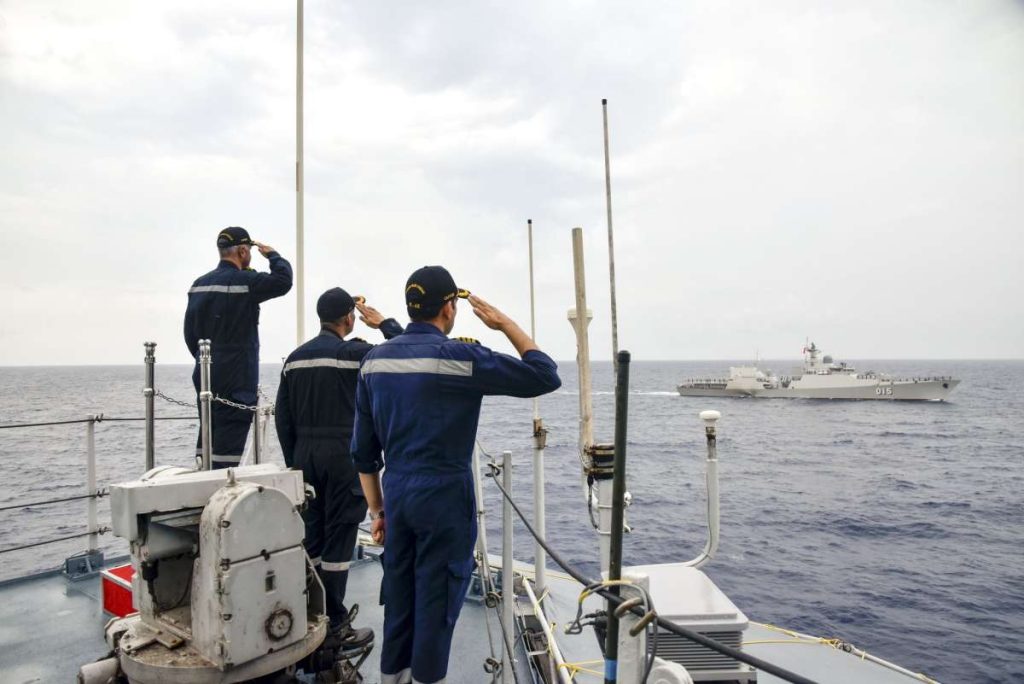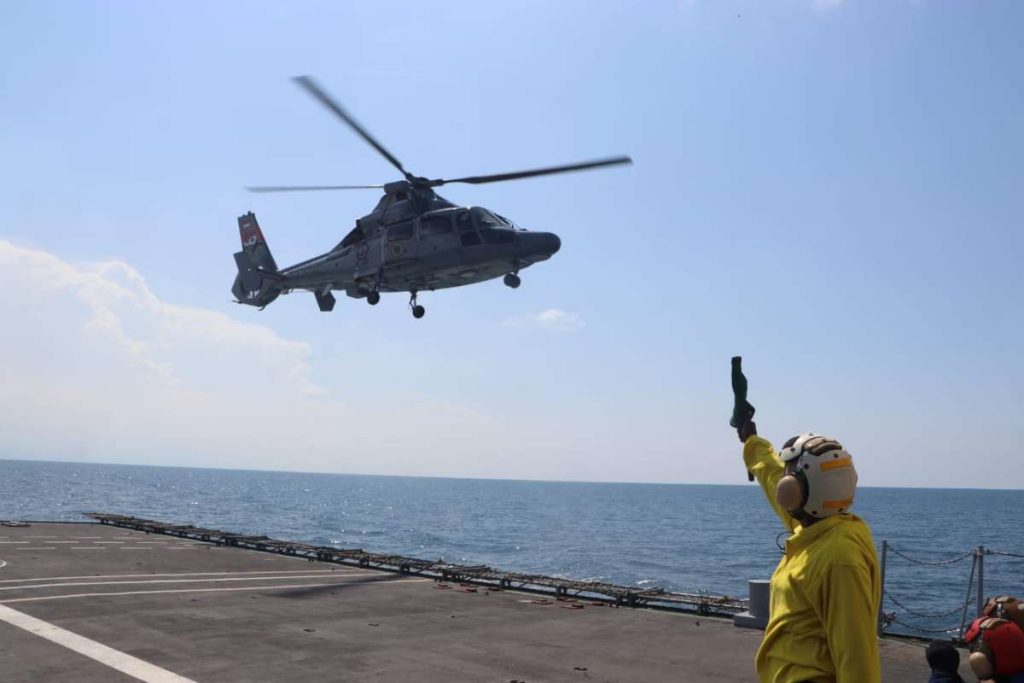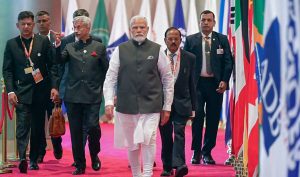In the evolving strategic rivalries of the Indo-Pacific region, Southeast Asia is playing a key role and China is seeing the challenges rising to its activities. Therefore, expansion of Indian maritime footprint in the region is a necessity to keep the strategic balance in the region, writes Sankalp Gurjar
Southeast Asia is at the heart of the Indo-Pacific region. ASEAN-centrality is the accepted principle of Indo-Pacific strategies of most countries. The maritime region stretching from the Andaman Sea in the West to South China Sea in the East links the Indian Ocean with the Pacific Ocean and a number of maritime chokepoints lie in this region.
For China, the region is key in venturing out in the Indian Ocean and therefore, it seeks access and facilities in this region as seen in its efforts to modernize the Ream port in Cambodia. Ream is likely to emerge as a de-facto Chinese base in Southeast Asia. However, China is not the only player in the Southeast Asian strategic landscape. Other key powers like India, Japan and the United States (US) are also becoming active in Southeast Asia to regain their pre-eminence.
As a result, the region is experiencing the strategic contestation between China on the one hand and India, Japan, and the US on the other. India is engaging with Southeast Asian countries in a bilateral as well as regional setting and maritime security is a key focus area for India-Southeast Asia strategic relationship. A spate of recent naval activities by New Delhi indicates the growing maritime footprint of India in the Southeast Asian waters.

The most visible manifestation of India’s growing role in maritime Southeast Asia has been the India-ASEAN maritime Exercises (AIME). They took place in two phases: first, near the strait of Malacca and second, in the South China Sea. Given the maritime disputes between China and five ASEAN countries (Vietnam, Philippines, Brunei, Indonesia, and Malaysia) in the SCS and the Chinese desire to dominate the South China Sea, AIME did not go down well in Beijing. China sent a flotilla of maritime militia through the ships that were participating in the AIME in the South China Sea phase. However, despite the Chinese reactions, to maintain the balance of power in the region and ensure the freedom of navigation and overflight, it is necessary to make exercises like AIME a routine affair.
Besides AIME, in this month, Indian naval warships launched coordinated patrols with Thailand, paid a port visit to Sihanoukville in Cambodia and exercised with the Indonesian navy. Of these three, Thailand and Indonesia are maritime neighbours of India and exercises with both have been aimed to foster interoperability, jointness and mutual cooperation. These countries are located near the geopolitically significant strait of Malacca. It is a lifeline for East Asian economies and China has been worried about the ‘Malacca Dilemma’.
Even though the co-ordinated patrols between India and Thailand have been going on since 2005, the changing regional strategic scenario increases their importance. Same holds true for India-Indonesia bilateral naval exercises named as ‘Samudra Shakti’ (translation: sea power). These exercises have been taking place since 2018 and signal the growing strategic convergence between India and Indonesia. In 2018, India signed an agreement to develop the port of Sabang in Indonesia near the strait of Malacca and China had reacted to that news with anger and bitterness.
Interestingly, India-Thailand patrol was focused on the Andaman Sea while India-Indonesia exercises took place in the South China Sea. Given the strategic importance of the South China Sea, India had deployed Dornier maritime patrol aircraft as well. The Indian Navy press statement about the India-Indonesia exercises notes that these drills will showcase ‘their shared commitment towards peace and stability in the region’. In this formulation, it is hard to miss the unstated but underlying reference to the Chinese behaviour in the South China Sea and its destabilizing impact on regional security.
Meanwhile, as China enjoys considerable influence in Phnom Penh, it is necessary to engage Cambodia and make efforts to wean it off from the Chinese orbit. The country is reeling under Chinese debt. Cambodia’s foreign debt stands at almost $ 10 billion and of which, it owes 41% to China. Therefore, Phnom Penh is under considerable Chinese influence and has been seen as one of the most pro-China Southeast Asian states. In this context, players like India and the US need to take steps to bring Cambodia out of the Chinese sphere of influence and diversify its strategic partners. The port visit to Sihanoukville by Indian naval warships point in that direction.

Last year, India sold BrahMos missiles to the Philippines. It was a show of intent on India’s part. Now, with the series of activities, New Delhi is expanding its naval footprint in Southeast Asia. In the evolving strategic rivalries of the Indo-Pacific region, Southeast Asia is playing a key role and China is seeing the challenges rising to its activities. Therefore, expansion of Indian maritime footprint in the region is a necessity to keep the strategic balance in the region. It helps to protect India’s interests as well as increases its influence. In the process, India-Southeast Asia relationship is deepening.
Eastern Indian Ocean
The Eastern Indian Ocean (EIO) is witnessing the increasing military presence of China. Two recent developments are significant in this regard: first, China’s People’s Liberation Army Navy (PLAN) has recently conducted maiden naval exercises with Cambodia.
It points to the strengthening of China-Cambodia defence ties. Moreover, China is upgrading and modernizing the infrastructure at the port of Ream in Cambodia, located on the Gulf of Thailand. As per reports, it includes a new command centre, meeting and dining halls, as well as medical outposts. A drydock, slipway, and two new piers will also be constructed. China will also undertake dredging to prepare the port for hosting larger vessels, presumably naval warships. China is deeply invested in Cambodia including through the Belt and Road Initiative (BRI) and the foothold at Ream will increase Beijing’s ability to project power in maritime Southeast Asia.
The second important development was about the likelihood of China developing military facilities on the Great Coco Islands of Myanmar. Taken together, India’s China challenge is set to intensify in the EIO.
The EIO is at the heart of the Indo-Pacific region. It links the Western Indian Ocean with the Western Pacific Ocean. The countries of Southeast Asia and Australia are located along the EIO. The sea lanes passing through the EIO facilitates the trade as well as naval presence of East Asian countries including China in the wider Indian Ocean region. The straits of Malacca, Sunda, Makassar, and Lombok are becoming increasingly important in this regard. In fact, for the last two decades, China has remained worried about the ‘Malacca Dilemma’ as the majority of its energy imports pass through the strategically located waterway. It fears that the hostile powers will cut off its access to the strait of Malacca and will be able to put pressure on China. Therefore, Beijing has vehemently objected to India’s plans to develop the port of Sabang in Indonesia. It worries that the foothold at Sabang and the strategic position of India’s Andaman and Nicobar Islands, where New Delhi is fast-developing military infrastructure, near the strait of Malacca will worsen the situation for China.

As a result, China has been frantically making efforts to overcome the ‘Malacca Dilemma’. Overland energy pipelines via Central Asia and Russia are aimed at alleviating this problem. Moreover, the China-Pakistan Economic Corridor (CPEC) and China-Myanmar Economic Corridor (CMEC) also include the network of energy pipelines that will help reduce the dependence on the strait of Malacca. These pipelines will directly bring supplies to mainland China. CMEC is more critical in this regard as it connects Yunnan province in southern China to the Bay of Bengal. The problem of dependence on the strait of Malacca provides a strategic rationale behind China’s attempts to increase and regularize its maritime military presence in the EIO. It seeks to ensure the security of its energy supply. In addition, China with its rapidly growing naval fleet, feels confident enough to venture out into the Indian Ocean and familiarize itself with the complex operating environment. The regular naval forays far away from the shores also help in training crews for longer-range deployments.
The intensification of military ties with Cambodia and Myanmar serves China’s multiple interests. First, for China, the regular naval exercises, military supplies, and port visits along with the access to strategically important locations like the Great Cocos Island and Ream naval base will help deepen the already close military-to-military ties with Myanmar and Cambodia. These two countries are acutely dependent on Chinese economic, diplomatic, and military support. In the wake of the military coup in Myanmar, the regime finds itself globally isolated and therefore, just like the 1990s, China’s influence is steadily growing in Myanmar. With Cambodia, its ties with the US have soured. At Ream, Cambodia has demolished the structures built by the US and even refused to allow Washington to repair the port facilities. In the vacuum, China has entered.
Second, the strategic location of these countries will be useful for China to establish a firm foothold in the EIO. The foothold in Cambodia and Myanmar will help Beijing keep a careful watch on the strategic activities of India in the region. It could monitor India’s expanding naval movements in the EIO more closely, and track missile tests conducted in the Bay of Bengal. In fact, there were rumours that in the 1990s, China had established a tracking facility at the Great Cocos Islands in Myanmar for precisely this purpose. A foothold in Myanmar and Cambodia will increase the strategic reach and presence of the PLAN. With the network of bases from East Africa (Djibouti), South Asia (Gwadar in Pakistan) to Southeast Asia (Ream in Cambodia), PLAN will be able to stay longer in the Indian Ocean and protect the interests of China.
Third, burgeoning ties with these two poor, authoritarian, and globally-isolated countries help Beijing to break the unity of ASEAN countries and sow discord over the issue of maritime disputes in the South China Sea. It weakens the resolve of Southeast Asian countries and countries like Vietnam and Philippines, that are locked in a dispute with China in the South China Sea, find it more difficult to deal with an assertive China. Sensing this, the Philippines is deepening its military ties with the United States (US). The recent agreement to allow the US access to four more bases in the Philippines and the decision to purchase BrahMos cruise missiles from India have to be seen in this context.
Beijing’s steadily expanding strategic activities in the EIO will further worsen India’s China challenge. The role of Andaman and Nicobar Islands in India’s Indo-Pacific strategy has never been as important as it has become now.
[Sankalp Gurjar is an Assistant Professor at the Department of Geopolitics and International Relations, Manipal Academy of Higher Education, Udupi, India. He is the author of The Superpowers’ Playground: Djibouti and Geopolitics in the Indo-Pacific in the 21st Century (Routledge: 2023)]






